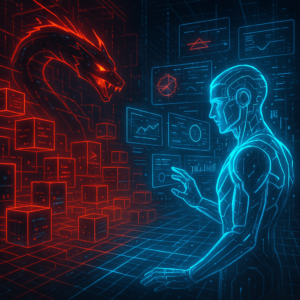
The Rise of Defensive Deception
June 20th, 2025 - Written By Cyber Labs
How Today’s Cyber Defenders Are Setting Smart Traps
Latest Updates (May–June 2025)
- Google’s AI Safety Charter in India (June 2025): Designed to combat the growing wave of AI-enabled cyber fraud targeting Indian users, Google aims to prevent over ₹20,000 crore in damages using deception-based AI defenses integrated into UPI, banking apps, and mobile authentication protocols.
- FBI alert on AI deepfakes (May 2025): The FBI reported a surge in malicious actors using AI to impersonate senior U.S. officials in phishing and social engineering campaigns, urging the adoption of behavioral honeynets and LLM-tracing defenses.
- Fortinet’s RSAC 2025 report: Cybersecurity leaders outlined how attackers are now renting AI-as-a-service models to craft polymorphic payloads while defenders deploy agentic deception systems capable of generating dynamic decoys at scale.
Takeaway: Cyber deception is moving from theory to action in large-scale, real-world deployments.
1. Introduction
In 2025, the cybersecurity battlefield is no longer one of passive defence. As adversaries adopt AI to automate reconnaissance, phishing, and payload generation, defenders are increasingly turning to defensive deception: a proactive approach to mislead, engage, and outmanoeuvre attackers.
Rather than just fortifying the castle, deception turns the entire landscape into a tactical game board. Every misstep by the attacker is logged, analysed, and used to harden defences further.
2. What is Cyber Deception?
Cyber deception involves the use of false assets, signals, and traps to identify and delay intrusions. These include:
- Honeypots that mimic vulnerable systems.
- Honeytokens like fake credentials or fake documents.
- Decoy admin panels or fake endpoints.
- Breadcrumb trails left to trick attackers into revealing their methods.
These aren’t brand new ideas but in 2025, they’re powered by AI, making them smarter, harder to detect, and highly adaptive.

3. Why Now? The 2025 Imperative
Attackers are moving faster and with more precision, thanks to tools like FraudGPT, deepfakes, and social engineering bots. The gap between attacker speed and traditional defence is widening.
What deception brings is a new kind of parity. Instead of reacting to breaches, defenders are now preemptively engaging attackers. This approach has proven to:
- Significantly reduce detection times.
- Increase the cost and risk for attackers.
- Provide valuable insights into new tactics and tools being used.
4. AI vs AI: The Deception Arms Race
Today’s attackers use AI for everything—from writing realistic phishing emails to automating scans for vulnerabilities and simulating legitimate user behaviour.
In response, defenders are:
- Using self-adaptive decoys that change dynamically.
- Employing fake LLM-powered chatbots to waste attacker time.
- Monitoring decoy environments to predict attacker behaviour.
- Integrating deception directly into threat detection systems.
It’s no longer just AI helping attackers; it’s AI battling AI in real time.
5. Real-World Applications
Sectors like finance, healthcare, and cloud-based services are already seeing results from deception strategies.
Financial institutions are catching internal data leaks using fake account records. Healthcare providers deploy decoy databases to identify ransomware attempts before any real data is touched. Cloud companies are planting fake IAM credentials that alert security teams as soon as they’re accessed.
Decoy chat interfaces, fake APIs, and synthetic SaaS environments are now part of mainstream incident detection.
6. Ethical & Operational Challenges
With any powerful tool comes the need for responsibility. Cyber deception raises questions:
- What if a legitimate user stumbles into a decoy?
- Could this be considered entrapment?
- Are we creating noise that overwhelms our own teams?
The key is to deploy deception alongside strong behavioural analytics and access control. When used carefully, deception is an enhancement not a replacement for traditional security practices.
7. The Future of Deception
Looking ahead, we’ll likely see:
- Dynamic deception tools that morph as attackers probe.
These are advanced tools that change their behavior in real-time based on how an attacker is interacting with them. For example, if a hacker starts scanning a fake server (a decoy), the system might adjust its responses to look more realistic or lead the attacker further into a false environment.
These tools can “morph” meaning they adapt their data, network signatures, or system appearance making it harder for attackers to tell what’s real and what’s bait.
“Think of it like a trap that reshapes itself based on how the intruder steps into it.”
- LLM-based trap agents that hold full conversations.
LLMs (Large Language Models) like ChatGPT can be turned into interactive decoys digital traps that simulate real users or admins. If an attacker tries to phish or socially engineer a system, the LLM-based bot could respond naturally. This wastes the attacker’s time and collects intelligence about their methods.
“Imagine a hacker chatting with what they think is a careless IT admin, but it’s an AI set up to learn from them.”
- Mainstream platforms offering deception-as-a-service.
Deception used to require custom tools and setups. Now, cloud providers and security platforms are starting to offer it like any other service:
- Plug-and-play honeypots.
- Fake user accounts, fake databases, fake APIs — all pre-built.
This makes deception tech accessible even to small businesses or startups.
“Think AWS or Azure offering “decoy servers” as easily as they offer storage or compute.”
- National cybersecurity policies endorsing deception as a standard.
Governments are starting to officially support and recommend deception in their cybersecurity frameworks:
Some national strategies are encouraging critical infrastructure (like energy, finance, or healthcare) to use deception to detect advanced threats.
It might soon be part of compliance — not just a “nice-to-have” but a required security layer.
“What firewalls were in the 2000s, deception might be in the 2030s.”
This isn’t science fiction, it’s already happening.
8. Final Thoughts
As AI raises the stakes in cyber conflict, deception offers a bold countermeasure. It shifts defenders from reactive to proactive, from blind to insightful. In the end, deception isn’t just about catching attackers, it’s about reshaping the entire battlefield.
It’s time we stopped playing defense. It’s time we started playing smart.
“In the game of cyber warfare, deception is the art of turning the hunter into the hunted. The best defense is an illusion that leads the enemy astray.”
check more blogs on: CyberLabs Blogs
Follow Us on: CyberLabs LinkedIn


